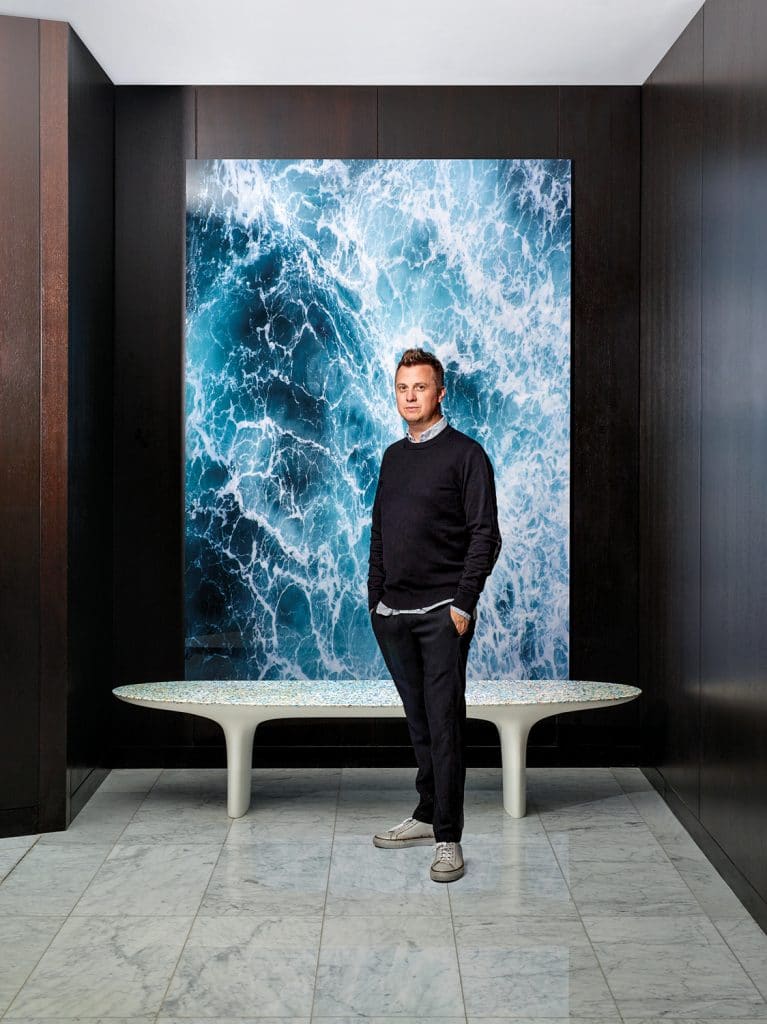Upcycling Interior Design Without Downsizing Luxury

Clients are increasingly wanting to use sustainable products, but for our latest contemporary home project, the brief is more specific. Our quest is to use some interior design upcycling through our materials, that don’t compromise on style or practicality and are luxurious.
Sourcing upcycled finishes for this new build home in Bracklesham Bay, West Sussex has been a new challenge. The finishes need to work with our interior design scheme which is full of calming sea tones and sky colours, complementing its large windows framing views to the Solent.
First up, like me, are you fed up with seeing the same old wooden dining tables everywhere? Looking for a new surface that can make a feature of the dining table, especially in a large open plan kitchen/dining room? The search for something unique which would echo the sea view palette led me to the decorative panels made by Smile Plastics. They can be used for many functions including furniture.

Bespoke tabletop by Smile Plastics
Smile Plastics create really innovative solid surfaces made from recycled plastics from various other waste streams too. They have many advantages, being 100% recycled and Volatile Organic Compound (VOC) free. Importantly they are stylish and up to date, without looking recycled, with clear strong colours and defined textures. Perfect for contemporary interiors.

Smile Plastics Transform Waste
Excitingly, with Smile’s products, you can fashion the finish to make your project unique, choosing the waste stream to get the colours and texture you want. Making your very own surface, with its own recycled story.

Recycling plastic by Smile Plastics
If you aren’t convinced that repurposed plastic can be beautiful, then look at the work of Australian artist Brodie Neill, he has developed a composite material made out of plastic waste from the sea “Ocean Terrazzo’. You have to admire his stunning furniture which sells on the collectors’ market from £30,000 for a bench.

Ocean Terrazzo by Brodie Neill
This stunning speckled table graduates ocean blue tones, reflecting its history derived from salvaged tiny pieces of plastic. These have been collected from seashores all over the world, from Tasmania to Cornwall. Photos by Dezeen.

Ocean Terrazzo Table by Brodie Neill
Upcycling uses a variety of waste streams, including glass which reflects the light and provides jewel-like colours rather than plastic. When hunting for something different to use as a bespoke kitchen worktop I found the amazing Resilica – based in East Sussex using 100% recycled glass waste, mixing it with a solvent-free resin and then casting it in panels. A myriad of options is open to the designer mixing resin and glass colours – ensuring a unique blend for your kitchen or bathroom.

Waterfall Island with recycled worktop by Resilica
In this kitchen the countertops are made from chips of old windows and broken windscreens.

Upcycled glass countertop by Resilica
I love this Resilica kitchen ledge is composed of a monochrome palette, it’s incredibly smart and urban, and forecasters predict is a strong emerging trend.

Monochrome Kitchen splashback by Resilica
I was especially excited to be one of the first to view the new launch of LuxuryEco collection of upcycled carpets by British designer Matthew Wailes and immediately started selecting potential carpets from an impressive array of colours and textures.

Choosing colours from Matthew Wailes’ newly launched Upcycled Carpets range
Ticking the luxurious, stylish and upcycled boxes with ease makes these carpets and rugs some of the most useable and innovative products I have found lately. My clients will love them for being beautiful, soft to touch and made to last. And most importantly taking some plastic out of the ocean, whilst putting it to good use.

Matthew Wailes Upcycled Rug
The rugs are made in Thailand, which currently is the world’s fifth-biggest contributor to plastic pollution. Yet, they are also undertaking a major programme of plastic waste removal from the sea.

Collecting plastic to by upcycled into Carpet
The story following the plastic from the ocean to becoming a soft, luxurious carpet is a fascinating one and I will share more details with you soon.
Another waste stream is yarn, many fabric suppliers are now exploring incorporating reused yarn or making yarns from upcycled plastic. One sustainable and affordable option is found at the British fabric designer Ian Mankin who has started “The Zero Waste Initiative”.

Ian Mankin Zero Waste Initiative
Their Lancashire weaving mill is determined to reduce its waste. Instead of sending unused yarn and offcuts to landfills, their designers and weavers are turning them into new fabrics. The designs are limited editions runs but the classic style, with universal appeal, means they will endure in a family home for years to come.
Interior design materials upcycling doesn’t mean compromising on style, I’m sure you will agree. It’s good news to know that there are so many designers turning unwanted waste into clever designs that reflect our shift in purchasing habits and lifestyle.
For advice on sustainable interior paints, bed furnishings, etc.

